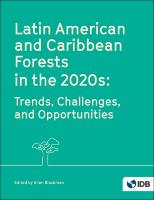Latin American and Caribbean Forests in the 2020s: Trends, Challenges, and Opportunities
Fecha de publicación
05-2020Autor
Ardila, Juan
Arieira, Julia
Simone Carolina, Bauch
Tathiana, Bezerra
Blackman, Allen
David, Olivia
Finegan, Bryan
Nascimento, Nathália
Nepstad, Dan
Nobre, Carlos A.
6 autores más.
Tipo
Libro
Metadatos
Mostrar el registro completo del ítemResumen
Forests are among Latin America and the Caribbean’s (LAC’s) crown jewels. The region boasts roughly a third of the world’s forests, half of its tropical forests, and a quarter of its mangroves (Blackman et al. 2014). This rich natural capital provides vital ecosystem services. At the global level, LAC forests remove vast quantities of carbon dioxide from the atmosphere (1.2 ± 0.4 Pg C per year), store almost half of the aboveground carbon in the tropics, circulate moisture at a continental scale, provide habitat for roughly half of the world’s terrestrial species, and host seven of the world’s 25 biodiversity hotspots (UNEP 2010; Gibbs et al. 2007; Werth and Avissar 2003; Meyers et al. 2000). At the local level, LAC forests regulate surface and groundwater quality, moderate temperature, and provide valuable economic and cultural goods and services, including 8 percent of the world’s industrial wood products (Baker and Spracklen 2019; Anderson-Teixeira et al. 2012).
Palabras clave
Editor
Banco Interamericano de Desarrollo, San José (Costa Rica)
URI (Enlace permanente para citar o compartir este ítem)
https://repositorio.catie.ac.cr/handle/11554/10529Colecciones
- Publicaciones y documentos [4419]


